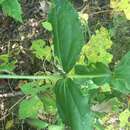Comments
(
Inglês
)
fornecido por eFloras
Silene ovata is a very distinctive species with large, ovate, acuminate, sessile, paired leaves, and very narrowly lobed white petals. The flowers open at night and are moth-pollinated.
- licença
- cc-by-nc-sa-3.0
- direitos autorais
- Missouri Botanical Garden, 4344 Shaw Boulevard, St. Louis, MO, 63110 USA
Description
(
Inglês
)
fornecido por eFloras
Plants perennial, rhizomatous; rhizome creeping. Stems erect, usually simple, 30-150 cm, with short, dense, eglandular pubescence, sparsely so toward base. Leaves sessile, 2 per node; blade prominently 3-5-veined, ovate-acuminate, round at base, (4-)6-10(-13) cm × (20-)30-50(-90) mm, appressed-pubescent on both surfaces. Inflorescences paniculate, narrow, many-flowered, open, bracteate, pedunculate, 10-50 × 3-5 cm, densely puberulent; bracts narrowly lanceolate, 3-15 mm, apex acuminate; peduncle ascending. Pedicels ascending, recurved near apex, ca. equaling calyx. Flowers nocturnal; calyx prominently 10-veined, tubular to narrowly campanulate and 6-9 × 3-4 mm in flower, turbinate and 10-12 × 4-5 mm in fruit, narrowed proximally around carpophore, veins parallel, green, broad, with pale commissures, puberulent, sometimes with few glands, lobes triangular-acute, 2-3 mm; corolla white, clawed, claw equaling calyx, broadened into limb, limb obtriangular, deeply lobed, 7-9 mm, lobes ca. 8, linear, appendages minute; stamens slightly longer than corolla; styles 3, ca. 2 times as long as corolla. Capsules narrowly ovoid, slightly longer than calyx, opening by 3 (splitting into 6) ascending teeth; carpophore 2-2.5 mm. Seeds dark brown, reniform, 0.8-1.5 mm, shallowly tuberculate. 2n = 48.
- licença
- cc-by-nc-sa-3.0
- direitos autorais
- Missouri Botanical Garden, 4344 Shaw Boulevard, St. Louis, MO, 63110 USA
Distribution
(
Inglês
)
fornecido por eFloras
Ala., Ark., Ga., Ky., Miss., N.C., S.C., Tenn., Va.
- licença
- cc-by-nc-sa-3.0
- direitos autorais
- Missouri Botanical Garden, 4344 Shaw Boulevard, St. Louis, MO, 63110 USA
Flowering/Fruiting
(
Inglês
)
fornecido por eFloras
Flowering late summer-fall.
- licença
- cc-by-nc-sa-3.0
- direitos autorais
- Missouri Botanical Garden, 4344 Shaw Boulevard, St. Louis, MO, 63110 USA
Habitat
(
Inglês
)
fornecido por eFloras
Rich woods; of conservation concern; 1000-1900m.
- licença
- cc-by-nc-sa-3.0
- direitos autorais
- Missouri Botanical Garden, 4344 Shaw Boulevard, St. Louis, MO, 63110 USA
Silene ovata
(
Inglês
)
fornecido por wikipedia EN
Silene ovata, the Blue Ridge catchfly[2] or ovate-leaved catchfly, is a herbaceous plant in the family Caryophyllaceae. It is a perennial plant growing up to 1.5 m (4 ft 11 in) tall, that has numerous white flowers, each finely fringed with a tube. It has large opposite leaves without petioles, which are 5–12 cm (2.0–4.7 in) long and taper to a long point, and 2–5 cm (0.79–1.97 in) wide.[3][4]
Flowering
Jones lists the blooming season as from June to September.[5]

Habitat for ovate-leaved catchfly on the Sylamore District of the Ozark National Forest. Plants are in the middle of the photo, but occur on the adjoining bluffs and lower talus.

Roadside habitat and ovate-leaved catchfly plant at the same location as other photos
Range
While unknown in Florida, it occurs in most of the southeastern United States from Georgia, eight widely scattered Alabama counties,[6] to Mississippi and Arkansas (where it occurs only in eight counties in the Ozark region[7]), north into southern Illinois and Indiana, Kentucky, and Virginia.[2] The plants have a limited distribution range wide as indicated by their global G3 status.
Habitat
A flora of Kentucky lists the species as occurring in "dry to mesic forests"[5] while the flora of North Carolina lists the habitat as "rich woods."[3]
Chromosome count
2n = 48.[8]
Conservation status
Silene ovata is listed as G3 on the NatureServe conservation status, meaning it is vulnerable and globally rare. Typically G3 species have 21 to 100 occurrences globally, or have 3,000 to 10,000 individuals globally.
References
-
^ Silene ovata NatureServe
-
^ a b USDA, NRCS (n.d.). "Silene ovata". The PLANTS Database (plants.usda.gov). Greensboro, North Carolina: National Plant Data Team. Retrieved 15 November 2015.
-
^ a b Radford, A. E., H. E. Ahles, and C. R. Bell. 1968. Manual of the Vascular Flora of the Carolinas, The University of North Carolina Press, Chapel Hill, North Carolina, USA, p.448
-
^ Steele, W. C., ed. 1967. Wildflowers of the United States: Southeastern States, McGraw-Hill, New York, New York, USA, p.448
-
^ a b c Jones, R. L. 2005. Plant Life of Kentucky: An Illustrated Guide to the Vascular Flora. The University of Kentucky Press, Lexington, Kentucky, USA, p. 320.
-
^ a b "Alabama Natural Heritage Program website". Alabama Natural Heritage Program Website. 2011. Retrieved 2011-11-24.
-
^ a b "Arkansas Natural Heritage Commission website". Arkansas Natural Heritage Commission website. 2011. Retrieved 2011-11-18.
-
^ Smith, E. B. 1988. An Atlas and Annotated List of the Vascular Flora of Arkansas. University of Arkansas Department of Botany, Fayetteville, Arkansas, USA, p. 32.

- licença
- cc-by-sa-3.0
- direitos autorais
- Wikipedia authors and editors
Silene ovata: Brief Summary
(
Inglês
)
fornecido por wikipedia EN
Silene ovata, the Blue Ridge catchfly or ovate-leaved catchfly, is a herbaceous plant in the family Caryophyllaceae. It is a perennial plant growing up to 1.5 m (4 ft 11 in) tall, that has numerous white flowers, each finely fringed with a tube. It has large opposite leaves without petioles, which are 5–12 cm (2.0–4.7 in) long and taper to a long point, and 2–5 cm (0.79–1.97 in) wide.
- licença
- cc-by-sa-3.0
- direitos autorais
- Wikipedia authors and editors

